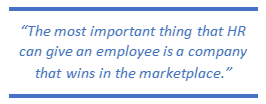
In David Greene’s Future of HR podcast with Dave Ulrich, Bridgette McInnis-Day, and Rupert Morrison, Greene mentions something that Ulrich said about the role of HR:

That quote focused my thinking. Future HR will not be the back-office support function it was when I earned my SPHR nearly 30 years ago. It’s time to step up and create real value.
The quote was in the context of a more extensive discussion about the current and future role of HR. It envisioned a shift from ensuring the people are happy so they can work to bringing them to happiness in work because what they do drives their success.
Greene’s panel discussion was about how HR drives value to customers, stakeholders, and their communities through talent, a successful organization, and leadership.
In my mind, it looks like this: 
HR drives business results by engaging the right talent, in a well-designed organization, with effective leadership that drives value at the point where the organization’s people interact with customers. That’s where we create a culture that feeds back into the business.
For us, that’s where HR creates value that can be measured through people analytics.
The HR tech industry tends to mystify people analytics, but we see it as using data to understand our people and our organizations to make better decisions. What and how you measure and analyze data depends on your organization maturity and what you want to achieve.
How can HR know what to measure?
As Rupert Morrison discussed in the podcast, it begins with asking questions beginning with “What if…?” If we have the right team together (more about that in a moment), we can work through our questions to asking the right question about what will drive value for our customers, stakeholders, community, or all three.
- What if we encouraged new employees to live within 15 or 30 minutes of their workplace and incentivized them to do it? Would that reduce their commuting time and encourage them to stay longer?
- What if we used VR to give new customer service agents hands-on experience in the scenarios they will encounter?
- What if we brainstormed all the factors that make people think about leaving, measured them, then designed interventions on the most important?
When you put the right people together, you will get many ideas. Narrow the ideas down to what impacts the business, then decide on the one question to answer. We recommend you think big but start small.
Build the Right Team
The right team is a diverse, cross-functional group of people from HR and other areas of the business that can help you do and measure the right things in the right way:
- Marketing can help with internal and external messaging and, most importantly, to help tell our story. When you are presenting results, the story is much more compelling than a bunch of statistics. Use a well-designed story to present only the numbers that matter.
- IT guides the team in the proper use of technology and keeps you out of the “shiny new” trap.
- Operations are the owners of the results and will often lead the team.
- Finance can bring financial acumen to the table if you are dealing with an initiative that requires funding or procurement.
- Analytics will help you make sense of your data and assist you with analytical methods. If you don’t have analytical skills available, you can engage a contractor or a service like Pixentia Analytics.
- Learning experts will be welcome if you need to work with learning results or design. They will look at your questions from their unique perspective and have suggestions for learning and development remedies.
Measure your Results
Once you have designed an intervention, implement it with the appropriate change management tools, and watch what happens.
Coming up with results comprises a series of questions:
- What moved?
- How much?
- What value was created?
- Does it matter?
Tell Your Story
A compelling story can make or break your success. We recommend you avoid trying to present more data than your audience wants to absorb. Make your story about people and frame it in a way that demonstrates the value to the business.
- Describe the problem and opportunity you observed and why you chose it. Show its impact on the people and the organization.
- Describe the solution and why you chose it. Briefly talk about alternatives and why you did not choose them. Be sure to include the impact of doing nothing.
- Show the results and discuss their short-term and long-term impact. Remember that it is OK to estimate the impact you have not yet measured.
- Deliver a quick, future-oriented wrap-up, with praise for the people who made it happen.
Get Started Now
You don’t need to be an analytical wizard to have an impact. Reach out for help when you need it. You may be surprised at the expertise you have available in your organization.
We believe the way to get started is to start. You may not think you are ready, but you may be surprised at what you can do with the right team around you.
Phenomecloud is a full-service technology company dedicated to helping clients solve business problems, improve the capability of their people, and achieve better results.




Leave a Comment